FHS Covid-19 Handbook
| Site: | School of Therapeutic Sciences Learning Zone |
| Course: | School of Therapeutic Sciences Learning Zone |
| Book: | FHS Covid-19 Handbook |
| Printed by: | |
| Date: | Monday, 3 November 2025, 7:32 PM |
Description

Foreword
The Wits COVID-19 Handbook is a guide for Wits University students and staff to access relevant information concerning the COVID-19 response during the 2021 academic year following COVID-19 Regulations and Guidelines for returning to campus, Blended Learning, Residence, Transport, and rules of conduct on Campus. The Handbook contains easy to access information related to COVID-19.
Use the links below to navigate through the Handbook. You can also access sections using the Modules or Pages tools
Intro and Purpose
INTRODUCTION
NTRODUCTION
The Wits COVID-19 Handbook is a guide and resource for all Wits University students and staff for use during the 2021 Academic year for up to date and relevant information pertaining to COVID-19. The Handbook describes the COVID-19 Regulations, Guidelines and Rules related to the safe return and start of courses for Wits students in the current COVID-19 pandemic.
The guidelines are based on government, non-governmental organisations and university documents released by the NDoHET, NDoH, NICD, Higher Health and Wits University amongst others. The Handbook follows recommendations by the Wits COVID-19 Emergency Response Plan.
The structure of the Handbook is purposeful, with “at a glance” content provided from the relevant sections of the national guidelines and recommendations followed by links to the full sources for further information.
PURPOSE
- Wits COVID-19 Student & Staff Handbook provides details to guide students and staff for day to day teaching & learning in times of COVID-19
- Provides standard, universal message, content, guidelines “at finger tips” (Evidence Based on COVID-19)
- Provides practical and applicable information for students and staff to adjust behaviour and day to day interactions and movements related to campus, classrooms, residence, clinical areas, transportation and other relevant areas
- Provides specific guidelines for COVID-19 related actions – Screening, sanitising, social distancing, use of masks, testing, quarantine and self-isolation
- Provides relevant academic and social support resources for students and staff during COVID-19 pandemic
Site developed and designed by the Faculty of Health Sciences Logistics/Operations Team. Site maintained by the Wits Faculty Return to Campus Task Team.
For any questions or explanations about information in this Handbook, please contact your Course Coordinator/Line Manager for assistance. For any healthcare concerns, please contact or visit Campus Health, a public health facility or contact your health care provider.
Emergency Contact Numbers:
- Campus Health and Wellness Centre on Main Campus is 011 717 9111
- Campus Health and Wellness Centre on Education Campus is 011 717 3294/5
- Click here for Wits Campus Heath and Wellness Centre website
- NICD COVID-19 HOTLINE is 0800 029 999
- Ambulance is 10177 from landline or 112 from mobile phone
- Wits Student Crisis Hot Line is 0800 111 331 (24 hours)
- Contact CCDU via email at info.ccdu@wits.ac.za or via telephone on 0117179140, click here for CCDU website
- Click here for listing of COVID-19 CALL CENTRES HOTLINES
- Click here for listing of relevant South African services for COVID-19 (Links to an external site.)
-
Wits Campus Protection Security Telephone Numbers:
- East Campus - Main Campus Control Centre, Robert Sobukwe Building: (011) 717 4444 / 6666
- West Campus, FNB Building: (011) 717 1842
- Education Campus, Administration Building: (011) 717 3340
- Parktown Health Sciences Campus: (011) 717 2222 / 2232
- Business School Campus: (011) 717 3589/3545
- External Campus Security: (011) 717 6192
- Click here for the Wits Campus Protection website.
What is COVID-19
WHAT IS THE CORONAVIRUS (COVID-19)?
According to the World Health Organisation, “Coronaviruses (CoV) are a large family of viruses that cause illness ranging from the common cold to more severe diseases. A novel coronavirus (SARS-CoV-2) is a new strain that has not been previously identified in humans. COVID-19 is the name of the illness caused by SARS-CoV-2.
HOW DOES IT SPREAD?
The disease can spread from person to person through small droplets from the nose or mouth, from sneezing or coughing. This means that the virus can spread from touching surfaces and then your nose or mouth as well as by breathing these droplets in or if droplets land in your eyes, nose or mouth.
SHOULD I BE WORRIED ABOUT CATCHING COVID-19?
The World Health Organisation (WHO) has issued the following information:
“Illness due to COVID-19 infection is generally mild, especially for children and young adults. However, it can cause serious illness: about 1 in every 5 people who catch it need hospital care”.
Source: http://www.kaelo.co.za/coronavirus
More information found at: South Africa COVID-19 Online Resource and News Portal
Distance, Dose, Dispersion: Experts’ guide on Covid-19 risks in South Africa and how to manage them
Click here to read the article to Understand the three things that can make the most difference to easing the lockdown and reopening South Africa with the least risk.
WITS COVID-19 South Africa Dashboard
Click here for WITS COVID-19 South Africa Dashboard for tracking cases
HELPFUL INFOGRAPHICS ON COVID-19
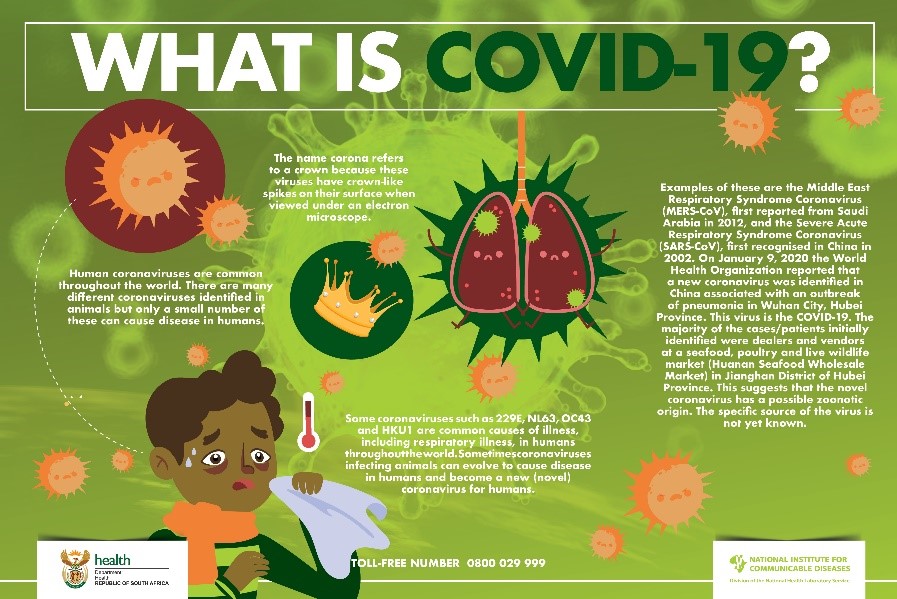
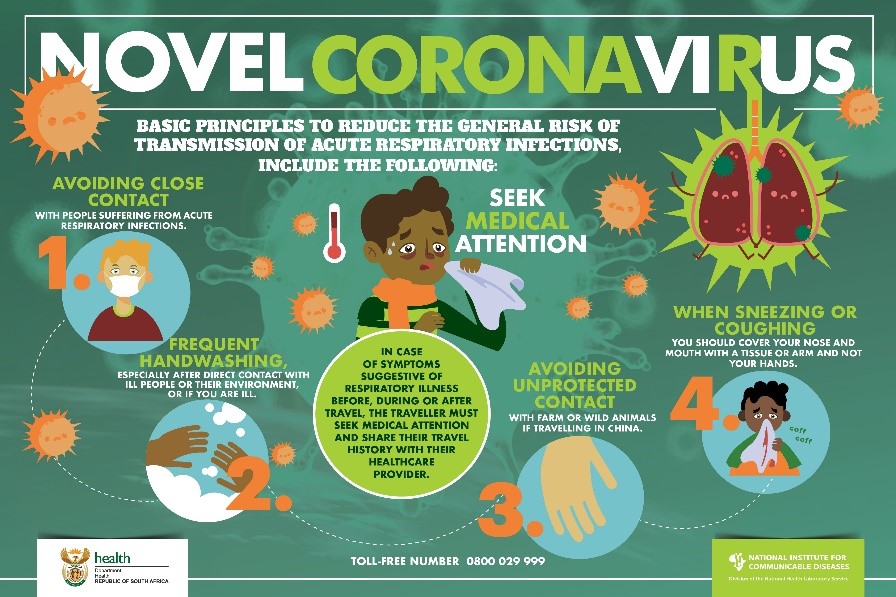
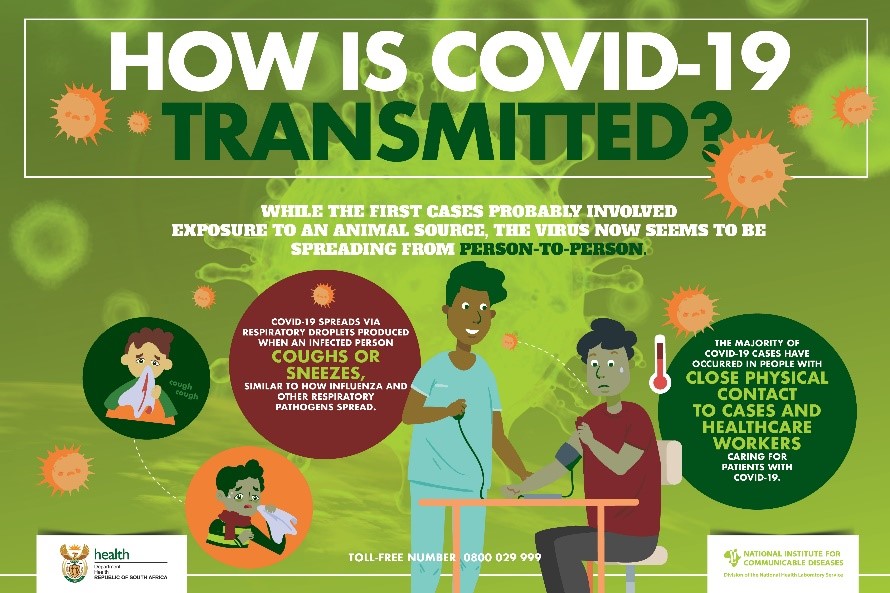
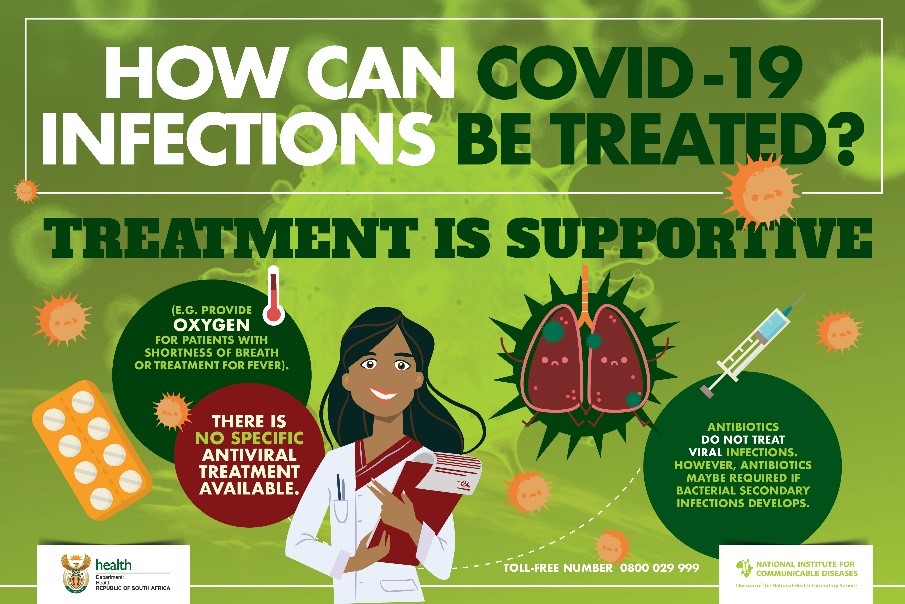
-
CORONA VIRUS (COVID-19) 24-HOUR HOTLINE NUMBER: (General public)
0800 029 999
-
CORONA VIRUS (COVID-19) 24-HOUR HOTLINE NUMBER: (Clinicians)
082 883 9920
-
CORONA VIRUS (COVID-19) WhatsApp number:
Send "Hi" to 0600 12 3456
Click here for link to SA COVID-19 Key Contact Directory

Helpful links for COVID-19 information:
National Department of Health COVID-19 website
National Institute for Communicable Diseases COVID-19 website
South Africa COVID-19 Online Resources & News Portal website
Screening and Testing

Contains 3 sections:
- Screening and Risk Scenarios
- Testing
- Quarantine / Self-isolation / Isolation
Screening and Risk Scenarios
WITS COVID-19 SCREENING APP
Wits has developed a COVID-19 Screening App called LogBox Patient App which can be downloaded from the App Store or the Google Play Store.
ALL STUDENTS AND STAFF TO COMPLETE THE SELF-SCREENING FORM ON THE APP EVERY DAY, BEFORE ENTERING CAMPUS, RESIDENCE, USING WITS TRANSPORT, ATTENDING CLINICAL SITES
- Download the Logbox Patient Application from the App Store or the Google Play Store. Click here for Logbox App in App Store. Click here for Logbox App in Google Play Store.
- Follow the initial instructions in the Wits Logbox brochure to set up the app.
- Fill in the screening form every day.
- You will receive a notice on your mobile phone that either clears you for entry or denies you entry to campus, residence, Wits transport or attending clinical sites.
- Show your clearance note to the security officers. If you receive a NOT clear message, you need to contact your Course Coordinator/Supervisor, immediately to be provided with advice for next steps.
For those staff members and students without smartphones or computers, hard copies of the screening form can be filled in and provided to Wits Security. Click here for link to Wits website with Logbox Screening tool information and paper-based form.
HONESTY & INTEGRITY
Students are reminded of the importance of honesty in completing the daily screening app. The falsification of information concerning COVID-19 is considered a serious misrepresentation during the State of Disaster Management and can potentially have legal consequences. Students are reassured that every effort will be made to complete the year for missed time.
SCREENING TOOL QUESTIONS
Wits COVID-19 Screening App asks the following questions.
- Do you have fever, dry cough, sore throat, redness of eyes, short of breath, body aches/muscle pains, loss of smell/taste, nausea/vomiting, diarrhoea, fatigue/physical weakness?
- Have you been exposed to someone diagnosed with Covid-19 or had recent contact with someone who is self-isolating whilst waiting for a Covid-19 test result?
- Have you been in quarantine/self-isolation for the past 14 days?
NEXT STEPS IF NOT CLEARED

If you answer "yes" to any question, you will receive a message as above, please contact your Supervisor/Course Coordinator and/or Campus Health to inform them that you are not cleared and use the following COVID-19 Risk and Scenarios table, with your Supervisor/Course Coordinator, to identify the Scenario, Risk level and subsequent steps to take if you are not cleared (e.g. you have a positive test, symptoms or exposure to a suspect or confirmed positive COVID-19 case.)
Emergency Contact Numbers:
- Campus Health and Wellness Ctr on Education Campus is 011 717 9113
- Campus Health and Wellness Ctr on Main Campus is 011 717 9111
- NICD HOTLINE is 0800 029 999
- Ambulance is 10177 from landline or 112 from mobile phone
- Office of Student Success COVID-19 Care Line is 076 518 7499 (office hours)
- Wits Student Crisis Line is 0800 111 331 (24 hours)
COVID-19 RISK AND SCENARIO TABLE
Use this table to identify the Scenario, Risk and subsequent steps to take should a student test positive, have symptoms and/or exposure to a COVID-19 presumptive or positive case. The table follows the guidelines presented by NDOH Occupational Health and Safety Committee – Covid-19 Response.
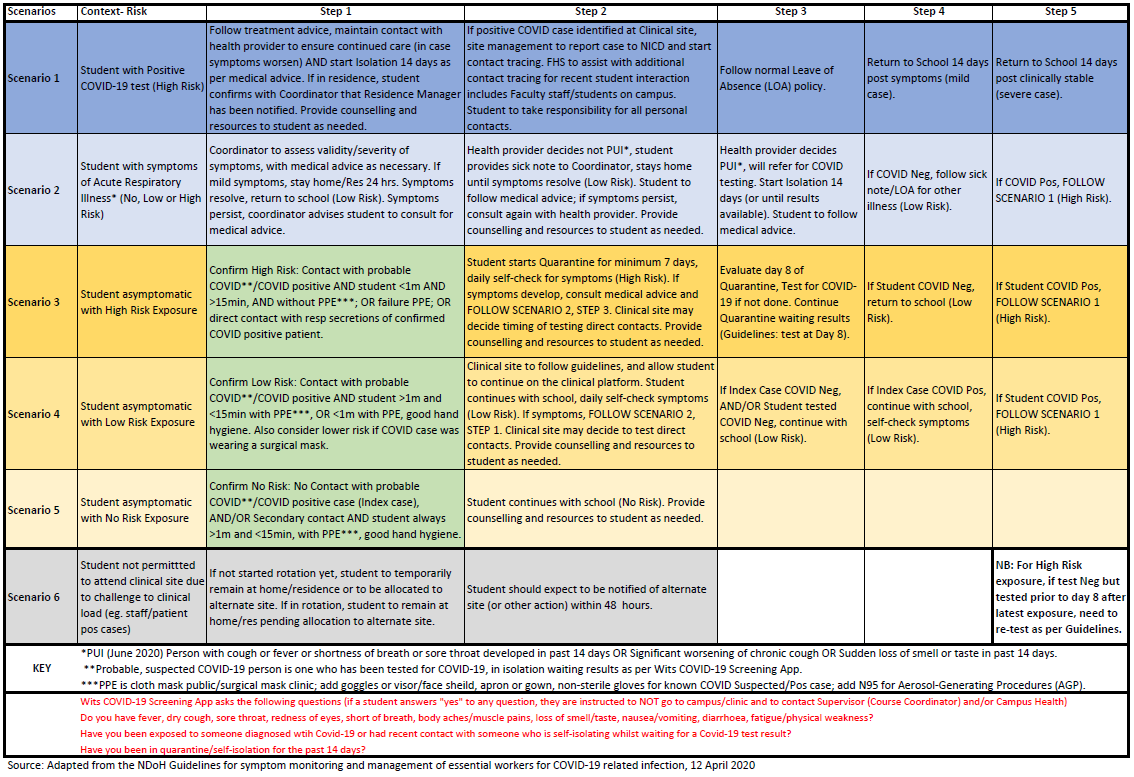
Additional Source: NDOH Guidelines for symptom monitoring and management of essential workers for COVID-19 Dec 2020 updates, no significant changes from June 2020 guidelines
Click here for Updated De-Isolation Guidelines, 17 July 2020
LEAVE OF ABSENCE
Students are not obliged to return to campus/clinical training if they have personal health or family considerations that prevent them from doing so, and are eligible to apply for Leave of Absence (LOA) for the remainder of the year. Students who become ill and/or are in Quarantine/Self-Isolation/Isolation are also able to apply for Temporary Leave of Absence (TLOA).
- Students should communicate with their Programme/Course Coordinator who will advise on the process for TLOA and LOA.
- All TLOA and LOA applications will be handled by the office of the Assistant Dean of Teaching, Learning and Undergraduate Affairs, Prof Judy Bruce.
- Instances where students may have to Quarantine/Self-Isolate or take TLOA due to COVID-19 infection will be considered on a case-by-case basis.
- Every attempt will be made to ensure that a student is not unfairly disadvantaged for having to quarantine/isolate.
- Evidence of online engagement during quarantine/isolation (mild symptoms) ensures eligibility to sit for theory assessments.
- For clinical students, evidence of clinical time make-up/catch-up, as documented in a dedicated logbook signed off by a clinical site supervisor, ensures eligibility to sit for clinical assessments.
- If make up time is not possible in current academic year, student may become asynchronous to complete requirements in 2021.
- Students are reminded that they must still meet all current Satisfactory Performance requirements per degree.
PLEASE NOTE in the case of the GEMP programme, TLOA or deferral of a rotation does not equate to a failed rotation, and would not necessitate having to repeat an entire year.
ACADEMIC SCENARIO TABLE
|
Clinical Risk & Scenarios |
Possibility of Quarantine or Self-Isolation/Isolation |
TLOA Period (estimate) |
Academic implications/outcomes |
|
Scenario 1, High Risk |
Positive test, 10 day Isolation from positive test date |
10 days |
Student’s health and well-being is always prioritised over their continued involvement in the academic programme.
Student continues with online programme during quarantine/isolation. Student can sit for theory assessment with demonstrated online engagement and catch up material as required. In addition for clinical students: Student supported to make up clinical hours in remainder of academic year. Practical assessment is withheld until all clinical time made up as documented in a dedicated logbook signed off by a clinical site supervisor. Student may need to be asynchronous to complete clinical hours in 2021 to meet all SP requirements per degree. By exception, individual departments will decide the threshold over which a student will need to repeat individual rotations/academic programme. This will be communicated to the Office of Teaching, Learning and Undergraduate Affairs. |
|
Scenario 2, Low to High Risk |
Symptomatic – mild/ moderate recovery time |
1 to 10 days |
|
|
Scenario 3, High Risk |
Quarantine for 5 days, (monitor for symptoms), if asymptomatic with Neg test on Day 5.
OR
|
5 days |
|
|
|
Quarantine for 5 days (monitor for symptoms), asymptomatic with Pos test on Day 5. Continue 10 days of Isolation from positive test date. |
14 days |
|
|
Scenario 4, Low Risk |
Return to campus |
0 to 1 day |
No impact to academic programme |
Testing
TESTING FOR COVID-19
Follow the latest National Department of Health (NDoH) and National Institute for Communicable Diseases (NICD) case definition for Person Under Investigation (PUI) to initiate COVID-19 testing.
Current case definition for PUI as of 2 April 2020:
TESTING OPTIONS
If you think you might have contracted the virus, you can call the NICD helpline (0800 029 999) and you will be advised on possible testing facilities. However, testing is not routinely done unless testing is indicated by a health professional therefore one would need to be assessed by a medical practitioner in order to qualify for testing.
Per the COVID-19 Risk & Scenarios table, a student with acute respiratory symptoms and/or contact with a COVID-19 positive case (without proper PPE) who meets the PUI criteria, can request for COVID-19 testing with a medical provider or public health facility, or visit Campus Health for advice. (Campus Health does not provide COVID-19 testing.) Click here for Wits Campus Health.
Public sector testing is free of charge. Private laboratories such as Lancet, Ampath and Pathcare can also test for SARS-CoV-2. Enquiry should be with the respective laboratory for their costing of the test. If going via a private lab, it is advisable to check with your medical aid to ascertain if they will cover the costs for the test.
Source: Coronavirus disease 2019 (COVID-19) Quick Reference for Health Workers, NDoH, NICD, 2 April 2020. NICD website for COVID-19 Guidelines
Click here for link to NICD website for COVID-19 Advice to Public, includes Frequently Asked Questions or SA Corona Virus website for Frequently Asked Questions
WHAT STEPS DO I FOLLOW TO TEST FOR COVID-19 ACCORDING TO PUI GUIDELINES?
- Confirm medical provider and/or clinical site has confirmed PUI status.
- Decide on testing facility location:
- Testing at a public clinical site near home/Residence
- Testing at private test facility if with medical aid
- If clinical student, testing at clinical site where student is allocated/based or testing at a public clinical site near clinical rotation.
- Please click here for a list of PHC Public healthcare facilities that are testing sites.
- Click here for a list of Lancet Laboratories for testing if with medical aid.
- Visit a clinic testing site closest and most convenient for you, goggle for the map location.
- Inform Course Coordinator of having been tested, circumstances around need for testing.
- Inform Residence Manager next (whether stay at a Wits Residence, Hospital Nurses Residence or non-Wits Private Residence)
- Begin Quarantine, Self-Isolation and/or Isolation following guidelines while waiting for test results (follow Quarantine/Self-Isolation/Isolation Guidelines in section below) and self-monitor for symptoms or worsening if present.
- If positive test result, follow Scenario 1 in Risk & Scenarios table above.
- If negative test result, continue to follow Scenario 2, 3 or 4.
WHAT DO I DO IF I TEST POSITIVE FOR COVID-19?
On receiving news that you have tested positive for COVID-19, your response may be one of anxiety and concern. This is understandable as you will be concerned for yourself and concern for others with whom you have come into contact recently.
Firstly, there is no reason to panic. You should remain calm and rational, as your own safety and those of others is supported by you responding to this news in a calm and rational manner. In fact, you can use your anxiety positively; you should use these emotions to help you focus on your next steps.
Step 1, you should self-isolate as soon as possible. If you have been classified as a high-risk exposure in accordance with the screening guidelines, you will already be self-isolating at home or in your university residence. Similarly, if you have been experiencing symptoms, you will be doing the same.
Any of us at any time may learn we test positive for COVID-19. Remember that the normal social distancing guidelines and Infection Prevention and Control (IPC) measures presume that anyone may have COVID-19, so in the immediate aftermath of receiving your news, you must simply be especially sure to adhere to the same guidelines as always.
- Wear a cloth face mask at all times when outside your home or Residence room
- Keep your distance from others 1.5 to 2m, and do not congregate
- Sanitize/wash your hands and the surfaces you come into contact with as regularly as possible
- Return to your home/residence to self-isolate and remain in your room following Self-Isolation/Isolation guidelines described in the next section
If you live in a Wits Residence and test positive for COVID-19
Be sure to inform both your Course Coordinator and your Residence Manager once you hear news of your test result. You need to start self-isolation (a person who tested positive and/or has symptoms who self-isolates in their own Residence room if able to) or start Isolation (a person who tested positive and/or has symptoms who relocates to a designated Isolation Residence).
If you can self-isolate in your own residence room and have a shared ablution/kitchen, use these common areas as sparingly as possible. Use these common areas on your own, wear a mask and sanitize all the surfaces with which you come into contact.
The university has agreed that each Wits Residence will have designated Isolation rooms available for Wits Residence students. If you can not Self-Isolate in your own residence room, then within 24 hours of your test results, you will be assisted to relocate to the designated Isolation room, or to a different facility for the duration of your period of Isolation. You will be able to apply for a Care Kit, with household goods as necessary, because you will not be able to shop during this period.
Please contact anelisa.mofakeng1@wits.ac.za from Office of Student Success to apply for a Care Kit with food and supplies. Or contact family members/relatives if they live within the area to help for food purchases and delivery.
Please follow the principles detailed in the national guidelines in the next section Quarantine/Self-Isolation/Isolation as applied to your context.
If you live in a Hospital Nurses residence and test positive for COVID-19
Be sure to inform both your Course Coordinator and your Hospital Nurses Residence Manager once you hear news of your test result. It may not be possible for a Wits students who resides at a Hospital Nurses Residence to Self-Isolate in the residence (i.e. Witswaters Nurses Res, CHBAH Nurses Res). In this situation, arrangements will be made for the student to Isolate at a Government Isolation Facility set up for Healthcare workers and clinical students who test positive and/or have symptoms and need to Isolate.
Please follow the principles detailed in the national guidelines in the next section Quarantine/Self-Isolation/Isolation as applied to your context.
If you live in a non-Wits Private Residence and test positive for COVID-19
Be sure to inform both your Course Coordinator and your non-Wits Private Residence Manager once you hear news of your test result. It may not be possible for a Wits students who resides at a non-Wits Private Residence to Self-Isolate in the residence (ie South Point, Student Digz, etc). However, arrangements will be made by the non-Wits Private Residence for the most appropriate location for the student to Isolate. This may require the student to re-locate to a Government Isolation Facility set up for Healthcare workers and clinical students who test positive and/or have symptoms and need to Isolate.
Please follow the principles detailed in the national guidelines in the next section Quarantine/Self-Isolation/Isolation as applied to your context.
If you live at home and test positive for COVID-19
Be sure to inform your Course Coordinator once you hear news of your test result. If your home situation does not equate with communal living of a residence, then self-isolation could be considered at home (for a person who tests positive and/or has symptoms and can stay in their own room in their home). However, the risk of infecting family members/housemates or anyone else you live needs to be acknowledged, and appropriate precautions must be taken. In this situation a student may need to Isolate in a Government Isolation Facility.
Please follow the principles detailed in the national guidelines in the next section Quarantine/Self-Isolation/Isolation as applied to your context.
CONTACT TRACING GUIDELINE
Contact tracing is being performed by NICD with every reported positive COVID-19 case. The Faculty of Health Sciences and the clinical sites, if relevant, can be proactive to inform any close contacts of the student.
- If the student was at a clinical site and subsequently tests positive for COVID-19, the student should provide the clinical site Preceptor with the locations and people they interacted with as close contacts for the clinical site to inform their staff and students.
- If the student was in an academic session, on campus, the student should provide their Course Coordinator with the location and people they interacted with as close contacts for the Course Coordinator to inform Wits staff and students.
- If the student was in a Wits Residence, Hospital Nurses Residence, non-Wits Private Residence, the student should provide their Residence manager with their location and people they interacted with as close contacts for the Residence Manager to inform the residents and staff.
- The student should inform all their close contacts who they interacted with 14 days prior to testing positive for COVID-19.
Quarantine / Self-isolation / Isolation
GENERAL GUIDELINES FOR QUARANTINE, SELF-ISOLATION AND/OR ISOLATION
Students who are required to begin Quarantine or to start Self-Isolation/Isolation should adhere to the following national guidelines during the required Quarantine/Self-Isolation/Isolation period.
Quarantine
Quarantine is for people who are asymptomatic, but may have been in close contact* with a known positive COVID-19 patient. Quarantine keeps these people away from others so they do not spread possible infection.
Quarantine is for the following:
- Students who are asymptomatic and in close contact* with a COVID-19 positive case.
- Students who are asymptomatic who tested for COVID-19 and waiting for test results.
*Close Contact: A person having had face-to-face contact (≤1 metre) or in a closed space with a COVID-19 case for at least 15 minutes without wearing masks. This includes:
- all persons living in the same household as a COVID-19 case
- people working closely in the same environment as a COVID-19 case
- healthcare workers/clinical students providing direct care for a COVID-19 case while not wearing recommended personal protective equipment (PPE)
Self-Isolation/Isolation
Self-Isolation/Isolation is for people who are symptomatic and/or test positive for COVID-19. Self-Isolation is to isolate in one’s own Residence room or own room at home. Isolation is to isolate at a designated Wits Residence Isolation Facility or Government Isolation Facility.
Self-Isolation/Isolation is for the following:
- Students who are symptomatic for COVID-19 and are waiting to be tested, or are symptomatic and have been tested for COVID-19 and waiting for test results.
- Students who are symptomatic with mild/moderate symptoms who tested positive (severe symptoms may need to be admitted to hospital for isolation).
- Students who are asymptomatic who tested positive for COVID-19.
Number of days one needs to Quarantine/Self-Isolate/Isolate
It is important to understand the purpose of Quarantine and Isolation is to reduce the risk of transmission of COVID-19 to other people. Therefore, one is under Quarantine/Isolation for the time period one is contagious. This period is sometimes difficult to calculate accurately, with most studies indicating a person is contagious 2 days prior to symptoms and 8 days following onset of symptoms. As stated by the Health Minister, DR Zwelini Mkhize: “Asymptomatic patients represent a conceptual challenge, since it is not possible to estimate where in the course of viral shedding they are at the time point at which they test positive.”
Given current information, the NDoH has updated the De-Isolation guidelines on 17 July, 2020 as the following:
Updated De-Isolation Recommendations, 17 July 2020
- Asymptomatic student requires isolation for 10 days after their positive test date.
- Symptomatic student with mild disease requires isolation for 10 days after the onset of their symptoms (regardless of a positive test date) provided their fever has resolved and their other symptoms are improving.
- Hospitalised patients with moderate-severe disease require isolation for 10 days following achievement of clinical stability (i.e. from when they are not requiring supplemental oxygen and are otherwise clinically stable).
- Students exposed in a high-risk scenario (who are asymptomatic) start quarantine and should have a negative COVID-19 PCR test performed on day 5 and experience no symptoms before they return to campus/clinical training. If they develop symptoms, or test positive, then follow above scenarios for De-isolation.
Repeat COVID-19 PCR testing is NOT required in order to de-isolate a patient and is not recommended.
Source: Reduction in the Isolation period for patients with confirmed COVID-19 Infection
Explanation of various scenarios
Scenario A: If a student has close contact* or high risk exposure to a COVID-19 case and they are asymptomatic, they need to start quarantine for 5 days, then on day 5 be tested for COVID-19 as per the updated national guidelines (of 17 July and of Dec 2020). If the test is negative, they can end quarantine, given they remain asymptomatic and can return to campus to continue school activities. If they test positive on day 5 and remain asymptomatic, they start isolation for 10 days from test date. If they develop COVID-19 symptoms, they continue to isolate for 10 days from onset of symptoms.
Scenario B: If a student develops symptoms of COVID-19, they may meet the criteria for a PUI and be tested. They will need to self-isolate/isolate while waiting to test and/or for test results to prevent possible further transmission of the virus. If the test is negative, they can end isolation, returning to campus when symptoms resolve for other illness, to continue school activities. If they test positive, they need to isolate for a total of 10 days from onset of COVID-19 symptoms, returning to campus when symptoms resolve to continue school activities.
Scenario C: If a student is asymptomatic and tests positive for COVID-19, they need to self-isolate/isolate for 10 days from the positive test date.
There is no need to test/retest at the end of the quarantine/self-isolation/isolation period. People discharged from quarantine/isolation after 10 days should self-monitor symptoms for a further 14 days, and report development of any symptoms to Campus Health, their general practitioner, to the NICD hotline or to their local health facility.
The layouts of the Wits Residences and Hospital Nurses Residence are not all conducive to quarantine and/or self-isolating students appropriately. Where possible, students can quarantine/self-isolate in their own room if with own (non-shared) kitchen and bathroom. If not, students will be moved to a Quarantine floor in the Residence, or moved to an Isolation floor or a different building or block, subject to using separate ablution, kitchen and recreational areas (i.e. common areas). Students must be able to meet the criteria of quarantine/self-isolation, if this is not possible, the student will be moved to a different residence/facility that meets the isolation criteria.
Wits FHS has a level of responsibility to oversee and monitor those students who may test positive for COVID-19 in Wits Residences.
CATEGORIES OF QUARANTINE/ISOLATION FOR WITS STUDENTS
The table below describes four categories of Wits students (who either live at a Wits Residence, Hospital Nurses Residence, non-Wits Private Residence or at home) and the ability for a student to quarantine, self-isolate or isolate in their current living situation, or if arrangements need to be taken to relocate. Steps are provided after the table for students to follow should they need to relocate from their current living situation to quarantine, self-isolate or isolate properly to follow the national guidelines.
|
Student Living situation |
Steps for Quarantine |
Steps for Self-Isolation/Isolation |
|
1. Wits Student who resides at Wits Residence |
1a. Student can Quarantine in own Wits Res room if with own self-cater kitchen and self-contained bathroom. Student stays in own room. |
1c. Student can Self-Isolate in own Wits Res room if with own self-cater kitchen and self-contained bathroom. Student stays in own room. |
|
1b. Student to move to a Quarantine area or floor in their Wits Res if Res with shared kitchen/bathrooms. Or Student moves to a different Wits Res set up for Quarantine. |
1d. Student to move to a Wits Res Isolation Block if room without own kitchen/ bathroom. Student to be transported & relocated to new Res by Wits. |
|
|
2. Wits Student who resides at Hospital Residence (e.g. Witwaters Nurses Res, CHBAH Nurses Res) |
2a. Student can not Quarantine own room because of shared facilities. Student to move to Quarantine area or floor in the Hospital Nurses Res (if available) |
2c. Student to Isolate in a Government Isolation Facility for HCW/clinical students. Student to be transported & relocated to Isolation Facility by Wits. |
|
2b. If Quarantine floor not available, Student to move to a Government Quarantine Facility for Healthcare workers/clinical students. Student to be transported & relocated to Quarantine Facility by Wits. |
2d. Student to Self-Isolate in Wits Res Isolation Block if space available with motivation for acceptance, and make full payment for Wits Res costs. |
|
|
3. Wits Student who resides at non-Wits Private Residence (e.g. South Point, Digz) |
3a. Student can not Quarantine own room because of shared facilities. Student to move to Quarantine floor in the non-Wits Private Res (if available) |
3c. Student to Isolate in a Government Isolation Facility for public. Student to self-transport & relocate to Isolation Facility |
|
3b. Student to move to a Government Quarantine Facility for public. Student to self-transport & relocate to Quarantine Facility. |
3d. Student to Self-Isolate in Wits Res Isolation Block if space available with motivation for acceptance, and make full payment for Wits Res costs. |
|
|
4. Wits Student who resides at home, private residence |
4a. Student to Quarantine in own room at own home (if meet criteria) |
4c. Student to Self-Isolate in own room at own home (if meet criteria) |
|
4b. Student to move to a Government Quarantine Facility for public. Student to self-transport & relocate to Quarantine Facility. |
4d. Student to Isolate in Government Isolation Facility for public. Student to self-transport & relocate to Isolation Facility. |
|
|
4e. Student to Self-Isolate in Wits Res Isolation Block if space available with motivation for acceptance, and make full payment for Wits Res costs.
|
Any Student can move home for Quarantine or Self-Isolation in any situation above if applicable. Provide own transportation.
STEPS TO FOLLOW FOR NEED TO QUARANTINE/ISOLATE IN RESIDENCE
1
- Student to begin quarantine/self-isolation/isolation as soon as possible.
- Any student who needs to start quarantine/self-isolation/isolation to contact their Course Coordinator, if not done so already to inform of the following:
- to be contactable by mobile phone and email at all times during their period of quarantine/isolation.
- to check-in with their Course Coordinator/Residence Manager twice a week.
- To declare any relevant co-morbidities to a Wits-designated clinician, to allow identification as vulnerable to more severe COVID-19 disease.
- To provide details of any health care practitioner involved in their care, allowing a Wits-designated clinician contact as necessary.
- To self-monitor for the development and/or worsening of symptoms, with special vigilance concerning possible progression of the disease.
3. Students to contact their Wits Residence Cluster Manager/Warden, or Hospital Nurses Residence Manager, or non-Wits Private Residence Manager to organise/verify for student to remain in current room, or if necessary for student to be relocated to another room available in a Quarantine Floor, or move to Isolation area of Residence or relocate to a Government Isolation Facility as needed. (See table above)
4.
- For Wits Residence Students in quarantine or self-isolation:
- Course Coordinator to contact Mr Nazime Randera, Assistant Registrar, Campus Housing and Residence Life at Nazime.randera@wits.ac.za who will inform Cluster/Res Manager
- Cluster manager will allocate a room appropriate for student situation (See table above)
- Res Manager to organise transport for student to travel from current location to designated Isolation location if necessary. (Wits transport service to be identified)
- Res Manager/student to inform Campus Health and Wellness Centre (CHWC) and Sister Maggie about the case and contact will be made with the student. Email Anna.Moloi@wits.ac.za
- The student will update CHWC for any changes in their health condition, i.e. worsening of symptoms, if any
- Thereafter, contact should be made by telephone to ensure quick response
- If a catered students, the student may continue booking meals and such will be delivered daily and placed at the door of the room. Student will be alerted to delivery of meals.
- If Self-catering, student will be allocated to a self-catering room with cooking facilities. Student may be provided with food parcels by the cluster manager or apply for Care Kit food parcel from OSS, email Makeadifference.health@wits.ac.za
- If need to be relocated to new room and within walking distance, a student will be encouraged to take basic necessities to walk to the new room
- If new room is of greater distance, transport will be arranged
- The quarantined student will be checked telephonically daily to establish possible needs they may have
- Student will be provided with cleaning material for the duration of their stay
- Student will be given time out of the Quarantine/Self-Isolation site if they have to go conduct further tests, otherwise students are to remain in their designated room
- All students to follow Quarantine/Self-isolation checklist when in their rooms as described below
CHECKLIST FOR QUARANTINE/SELF-ISOLATION/ISOLATION AT RESIDENCE OR HOME
- You should Quarantine/Self-Isolate/Isolate yourself at residence or home for number of days as described in guidelines.
- Quarantine/Self-Isolate/Isolate yourself in a separate, well-ventilated room at residence or home.
- Don’t go to school, campus, clinical sites or work. Do not leave you residence or home, unless for medical reasons.
- Avoid unnecessary travel outside your residence or home, and as far as possible avoid close interactions with other people.
- Visitors are not be allowed until you have completely recovered from signs and symptoms.
- You should clean your hands with soap and water frequently. Alcohol-based sanitizers may also be used, provided they contain at least 60% alcohol.
- Hand hygiene should also be performed before and after preparing food, before eating, after using the toilet, and whenever hands look dirty.
- Do not have visitors in your room at home/residence. Only those who live in your home should be allowed to stay. If it is urgent to speak to someone who is not a member of your household, do this over the phone.
- At home, you should stay in a specific room and use your own bathroom (if possible). If you live in shared accommodation (university residence or similar) with a communal kitchen, bathroom(s) and living area, you should stay in your room with the door closed, only coming out when necessary, if in self-isolation with symptoms, you should wear a surgical mask when using communal areas.
- If in self-isolation, with symptoms and others are in close proximity to you (due to necessity only, when in the same room, when using a shared bathroom/kitchen area), please ensure that you are wearing a surgical mask that is fitted tightly around your nose and mouth. The mask should be used when you are near other people until your symptoms have resolved or you have been informed by your doctor as such.
- You should practice good cough and sneeze hygiene by coughing or sneezing into a tissue, discarding the tissue immediately afterwards in a lined trash can, and then wash your hands immediately.
- Household/residence members should stay in a separate room/s from the suspected case. If this is not possible, a minimum distance of 1.5 to 2 meters should be maintained at all times. If you are symptomatic and need assistance, limit the number of caregivers. Ideally assign one person who is in a good health without underlying chronic conditions or immunocompromised conditions.
- The caregiver should wear a tightly fitted medical mask that covers his/her mouth and nose when in the same room with the patient. Masks should not be touched or handled during use. If the mask gets wet or dirty with secretions, it must be replaced immediately with a new, clean, dry mask. Remove the mask by using an appropriate technique (i.e. do not touch the front but remove the lace from behind). The surgical mask can be reused if not soiled, wet or degraded. Following mask removal, perform hand hygiene.
- Wash laundry at the highest temperature compatible for the fabric using laundry detergent. This should be above 60° C. If possible, tumble dry and iron using the highest setting compatible with the fabric. Wear disposable gloves and a plastic apron when handling soiled materials if possible and clean all surfaces and the area around the washing machine. Do not take laundry to a laundrette. Wash your hands thoroughly with soap and water after handling dirty laundry (remove gloves first if used).
- You should avoid sharing household items like dishes, cups, eating utensils and towels. After using any of these, the items should be thoroughly washed with soap and water.
- All high-touch surfaces like table tops, counters, toilets, phones, computers, etc. that you may have touched should be appropriately and frequently cleaned.
- Clean and disinfect frequently touched objects and surfaces with soap and water followed by 60% alcohol or bleach containing solution.
- Clean and disinfect bathroom and toilet surfaces at least once daily. Regular household soap or detergent should be used for cleaning and then, regular household disinfectant should be applied to these surfaces.
- Monitor your symptoms, take your temperature daily - Seek prompt medical attention if you develop symptoms or if currently with symptoms and they worsen. For example, if you have fever, cough, sore throat and/or difficulty breathing, then call your doctor, healthcare facility or Campus Health and or call the NICD Hotline to inform them of changes to your condition.
- Campus Health and Wellness Centre on Education Campus is 011 717 9113
- Campus Health and Wellness Centre on Main Campus 011 717 9111
- NICD HOTLINE is 0800 029 999
- If it is an emergency and you need to call an ambulance, inform the call handler or operator that you are being quarantined/ isolated for SARS-CoV-2.
- Ambulance is 10177 from landline or 112 from mobile phone
More information on Quarantine/Isolation: What to do if I test positive for coronavirus disease and I am asked to isolate?
Categories of people and quarantine/isolation recommendations per national guidelines, updated 13 July 2020
|
Category |
Quarantine |
Isolation |
|
Student asymptomatic with close contact* to positive COVID-19 person without social distancing |
Quarantine at home/Res for 10 days. If not possible, admit to a quarantine facility. If PUI and test neg, end quarantine. |
If test positive, start isolation, follow below |
|
Clinical student close contact to positive COVID-19 patient without proper PPE |
Quarantine at home/Res. If not possible, admit to a quarantine facility. If well, test on day 5 and if result is negative return to campus/school |
If test positive, start isolation, follow below |
|
Student with symptoms who meets PUI criteria, waiting test result |
Quarantine at home/Res for 10 days from onset of symptoms. If not possible, admit to quarantine facility. Can be released from quarantine if test result is negative. |
If test is positive, start Isolation, follow below |
|
Student asymptomatic who test positive for COVID-19 |
If test positive, student need to Self-Isolate/Isolate |
Self-Isolate at home/Res for 10 days from positive test date. If unable to self-isolate at home/Res, admit to isolation facility |
|
Student with mild symptoms who test positive for COVID-19 |
If test positive, student need to Self-Isolate/Isolate |
Self-Isolate at home/Res for 10 days from onset of symptoms. If unable to self-isolate at home/Res, admit to isolation facility |
|
Student who test positive for COVID-19 has been admitted to hospital |
If test positive, student need to Self-Isolate/Isolate |
Isolate at hospital. De-isolate 10 days after clinically stable (not requiring oxygen) or 10 days after onset of symptoms (if did not require oxygen) |
Source: Updated NDOH De-Isolation Guidelines as of 13 July, 2020
Source: NDOH Guidelines for Quarantine and Isolation COVID-19
Click here for more information on Quarantine/Isolation
FHS+PT+Bronchial+Hygiene+and+Exercies+during+Quarantine+_+Isolation+in+COVID19
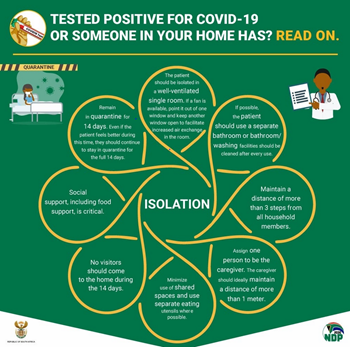
Click here for further information on Home Isolation from SA Coronavirus website
PPE Training and Information

This following sections will be covered:
PPE training
PPE training videos
Hand washing
Cloth masks
Social distancing
PPE Training
PPE TRAINING
Welcome to the Personal Protective Equipment (PPE) Training Workshop
Infection prevention and control is the first step for health and safety. Infection prevention and control (IPC) is a scientific approach and practical solution intended to prevent harm caused by infection to persons, patients and health workers. It is grounded in infectious diseases, epidemiology, social science and health system strengthening.
An important component of IPC is personal protective equipment (PPE) which is clothing or equipment designed to act as a barrier between an individual’s skin, mouth, nose, or eyes and viral and bacterial infections. Personal protective equipment (PPE) is specifically used to protect clinical and non-clinical health workers from exposure to body fluids or from droplet or airborne pathogens, chemicals or heat. The use of PPE is based on risk assessment and evidence of the route of transmission for a given microbe.
When used properly and with other infection control practices such as hand-washing, using alcohol-based hand sanitizers, and covering coughs and sneezes, PPE minimizes the spread of infection from one person to another.
All clinical sites will be providing required PPE to students. The University will provide two cloth masks (Wits logo) as well as once off, back up provision of PPE for your use in the event that you are not able to source these in your clinical sites. The Back-up PPE includes 1 box of 50 surgical masks, 1 set of goggles, 1 visor and 1 bottle of hand sanitising gel.
PPE FOR HEALTHCARE WORKERS AND STUDENTS DURING COVID-19
This poster from the NDOH demonstrates the three levels of PPE required for three levels of risk you may be exposed to when providing care for patients in the clinical settings. PPE for Low risk setting with treatment for non-COVID-19 patients is a surgical mask, no other PPE is needed. PPE for High risk settings with treatment of confirmed or presumptive COVID-19 patients is a surgical mask, apron, visor or goggles and non-sterile gloves. N95 mask is not needed unless performing aerosol-generating procedures (AGP) for confirmed or presumptive COVID-19 patients. Students are to follow these PPE guidelines along with protocols for each clinic/hospital.
I
INFECTION PREVENTION AND CONTROL
There are two main levels of IPC. 1) Standard Precautions are used for all patient care. They’re based on a risk assessment and make use of common sense practices and personal protective equipment use that protect healthcare providers from infection and prevent the spread of infection from patient to patient. 2) Transmission-Based Precautions are the second tier of basic infection control and are to be used in addition to Standard Precautions for patients who may be infected or colonized with certain infectious agents for which additional precautions, such as use of PPE, are needed to prevent infection transmission.
TRANSMISSION-BASED PRECAUTIONS OF IPC
|
IPC Measures |
Description |
Examples of PPE |
|
Contact Precautions |
Use Contact Precautions for patients with known or suspected infections that represent an increased risk for contact transmission. |
Hand hygiene, non-sterile gloves, apron/gown |
|
Droplet Precautions |
Use Droplet Precautions for patients known or suspected to be infected with pathogens transmitted by respiratory droplets that are generated by a patient who is coughing, sneezing, or talking. |
Hand hygiene, non-sterile gloves, apron/gown, surgical mask, goggles/face shield/visor |
|
Airborne Precautions |
Use Airborne Precautions for patients known or suspected to be infected with pathogens transmitted by the airborne route (e.g., tuberculosis, measles, chickenpox, disseminated herpes zoster). |
In addition to above, wear N |
CHARACTERISTICS OF SARS COV-2 IN RELATION TO IPC
Person to person transmission of SARS-CoV-2, is rapid causing large community outbreaks across the globe. The virus infects and colonises the human nasopharynx and upper respiratory tract, later affecting the lower respiratory tract leading to pneumonia, respiratory failure and sometimes death (variable case fatality rates reported 1-5%). It is an enveloped virus which makes it fragile and vulnerable to heat, chemicals and ultraviolet sunlight.
ROUTES OF TRANSMISSION OF SARS COV-2
There are only two known routes of transmission (WHO recommendations)
- Via respiratory droplets produced via sneezing, coughing which is directly inhaled person to person.
- Via respiratory droplets landing on environmental surfaces surrounding the infected person which are then transferred by the contact route via contaminated hands to a person’s face and mucous membranes.
No airborne transmission has been recorded except during aerosol generating procedures (AGP) in close proximity. In an analysis of 75,465 COVID-19 cases in China, airborne transmission was not reported.
When aerosols are generated during coughing and sneezing, the larger size droplets fall on surfaces surrounding the source person depending on the mass of the droplets (See Figure below). Airborne transmission requires air currents for movement of lighter particles such as Mycobacterium tuberculosis, measles and chickenpox. This has not been found in COVID-19 transmission yet.
This is crucial information for applying the correct IPC procedures and ensuring safety of you and your patients.
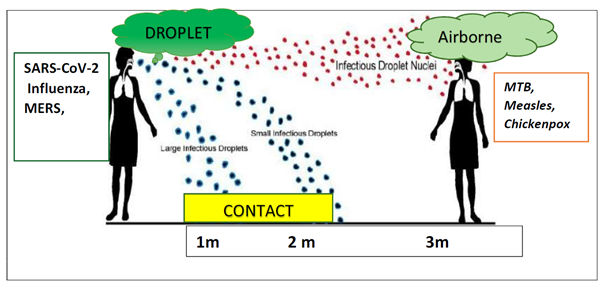
IPC PRECAUTIONS FOR COVID-19 CONTAINMENT
In addition to Standard Precautions, Droplet and Contact Precautions are recommended with use of the follow PPE for contact with suspected and/or positive COVID-19 patients:
- surgical mask
- gloves non-sterile
- apron (or gown)
- goggles/face shield/visor
The National Department of Health recommends the use of N95 mask for aerosol generating procedures (AGP), protecting for airborne precautions. There is no evidence that foot or head gear is indicated for protection against droplet and contact precautions and should be avoided.
AEROSOL GENERATING PROCEDURES (AGP)
An aerosol generating procedure (AGP) is where a large number of droplets are generated during a procedure, usually relating to the mouth and respiratory tract. Currently there is no evidence that other procedures where aerosols are generated such as orthopaedics, carry a risk of transmission SARS-CoV-2.
During AGP, an N95 respirator should be worn with a gown and/ or plastic apron, single pair of nonsterile gloves and eye protection, either goggles or a face shield.
In high risk areas where AGPs are being conducted (e.g. ICU)
- Intubation, extubation and related procedures such as manual ventilation and open suctioning
- Tracheotomy/tracheostomy procedures (insertion/open suctioning/removal)
- Bronchoscopy
- Surgery and post-mortem procedures involving high-speed devices
- Some dental procedures (such as high-speed drilling)
- Non-Invasive Ventilation (NIV) such as Bi-level Positive Airway Pressure (BiPAP) and
- Continuous Positive Airway Pressure ventilation (CPAP)
- High-Frequency Oscillating Ventilation (HFOV)
- High Flow Nasal Oxygen (HFNO), also called High Flow Nasal Cannula
- Induction of sputum for laboratory test
- Collecting nasopharyngeal and oropharyngeal swabs
- Chest physiotherapy
- Reprocessing ventilator circuits and respiratory equipment
- Cardiopulmonary resuscitation, including bag-mask ventilation
PPE SUMMARY
Clinical sites are to provide appropriate PPE to all students. It is now recommended that all clinical staff and students should wear surgical masks when consulting or examining patients, irrespective whether the patient is known to have COVID-19 or respiratory symptoms. It is essential that hand hygiene is carried out before and after each patient contact.
When in contact with suspected or positive COVID-19 patients, clinical staff and students to wear: surgical mask, apron, goggles/face shield/visor and non-sterile gloves.
When performing aerosol-generating procedures, clinical staff and students to wear: N95 mask, apron or gown, goggles/face shield/visor and non-sterile gloves.
RECOMMENDED PPE FOR CLINICAL SETTING
This is a very useful chart to see what PPE is recommended for clinical staff and students in contact with patients with or without COVID-19 in different clinical settings.
EXTENDED USE OF PPE
Usually PPE is discarded after a single patient or procedure, however, because of an acute shortage of PPE during the COVID-19 outbreak, the WHO and CDC are considering extended use and/or reuse of certain PPE. For South Africa, it is recommended that the extended use of PPE is preferable. See table below
Source document: COVID-19 Disease: Infection Prevention and Control Guidelines Version 2 (21st May 2020)
Sources: CDC website, NIOH website, NICD website, NDOH website
Read the instructions for the correct sequence to put on (Don) and remove (Doff) PPE in the clinical setting.
See also PPE Training videos below for donning and doffing.
PPE Training videos
Please watch these videos below which illustrates the method of donning and doffing PPE. The first video demonstrates the appropriate PPE for treating a presumptive and/or positive COVID-19 patient. The second video demonstrated appropriate PPE for performing aerosol generating procedures (AGP) for a presumptive and/or positive COVID-19 patient. The third video demonstrates correct technique for swab collection to test for COVID-19 and the fourth video is demonstrating proper hand washing technique.
The videos are hosted on youtube which is not zero-rated.
Hand washing
Hand hygiene is the mainstay of IPC and Standard Precautions. Hand washing must be done properly and for at least 20 seconds with soap and water. When washing hands, friction is necessary to remove transient microbes from the hands. Use of alcohol-based hand rub (ABHR) containing 70% propyl or isopropyl alcohol with emollient is also effective to kill SARS CoV 2.
When using ABHR, make sure all surfaces are covered. Dip fingers in the ABHR in your palm and then move to the other surfaces. Gloves do not offer total protection. ALWAYS WASH HANDS AFTER REMOVING GLOVES. Never apply ABHR to gloves. It damages them and increases the risk of contamination.
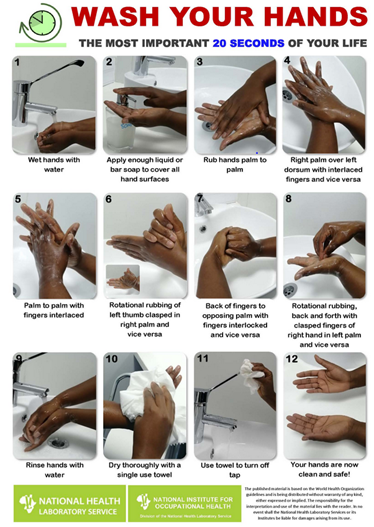
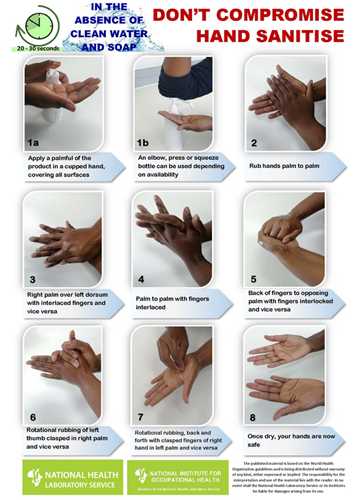
Source document: COVID-19 Disease: Infection Prevention and Control Guidelines Version 2 (21st May 2020)
Sources: CDC website, NIOH website, NICD website, NDOH website
Cloth Masks
Remember that according to government regulations, all persons out in public are required to wear a cloth face mask at all times. This will be necessary for you also as you travel and attend at campus and clinical sites.
Wearing a mask when in public places, especially crowded places, can help slow the spread of COVID-19. A recent study found incidence of transmission without a mask to be 17% which dropped to 3% when wearing a mask.
Even when wearing a mask, hand-washing and social distancing remain the most important interventions to reduce the spread of COVID-19. The same study found incidence of transmission when within 1 meter to be 13% which dropped to 2.6% when greater than 1 meter.
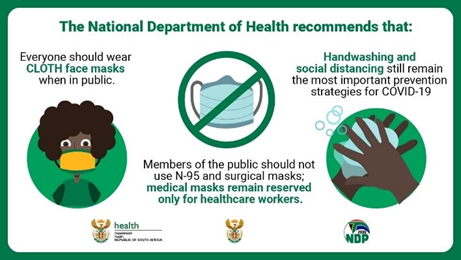
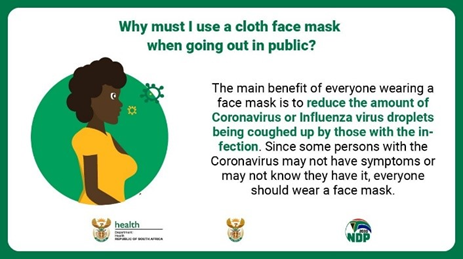
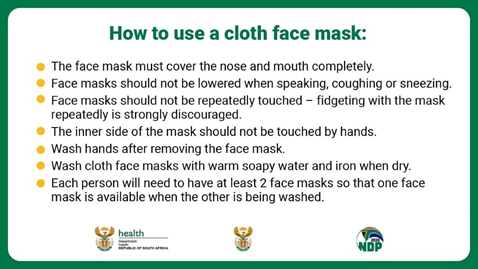
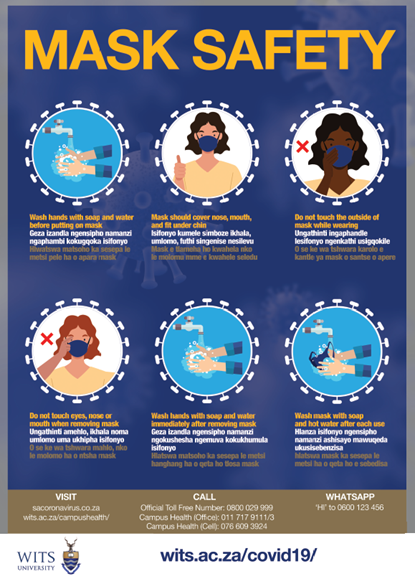
Social Distancing
Social distancing (sometimes known as ‘Physical distancing’) is about keeping a safe distance from others so that you reduce the transmission of COVID-19. It is recommended to be 1.5 to 2 meters apart from another person at all times. Social distancing is also about reducing the number of social contacts one has with different people and so minimising your, and their changes of being exposed to the virus.
This is about physical distance. For your own mental health, you can, and should, keep in touch with friends and family via the phone, or online. Keep yourself out of any situation where you come into face-to-face contact with others closer than 1.5 metres away. A recent study found incidence of transmission when within 1 meter to be 13% which dropped to 2.6% when greater than 1 meter.
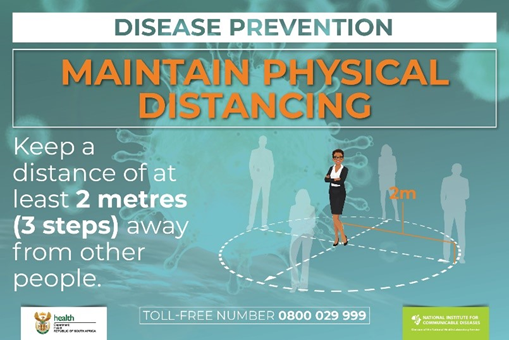
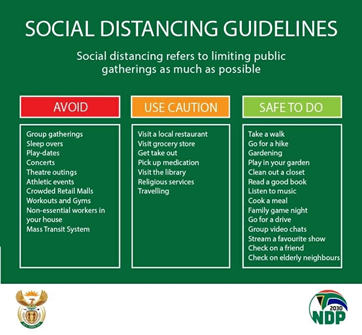
Clinical Sites

This section applies to those FHS students working in the clinical space, as student practitioners and members of the health care team to which they are allocated during clinical rotations.
This COVID-19 pandemic is causing considerable anxiety among communities worldwide. Health sciences students and professionals are not immune to this anxiety, in particular for working in the clinical setting. Comfort and strength can be drawn, however, from applying principles of professionalism and ethics to define own behaviour and attitudes during these difficult times. To this end, the FHS Professionalism and Ethics committee has developed a set of principles that can be helpful to staff and students alike.
Click here for Clinical Students in COVID-19 Crisis 2020 (PESC)
Click here for link to Hastings Center and Steve Biko Centre for Bioethics principles
The Wits FHS students are hosted at a wide variety of clinical sites, within the tertiary, secondary, district and community settings. As a member of the health care team, It is critically important that each student adheres to the rules and guidelines in place at their allocated site. While the Faculty prefers students to be allocated to non-COVID and/or low-risk settings, there is no restriction for students to learn in one setting or another. The emphasis is rather on students' adopting the appropriate mindset to infection prevention and control, and to own risk at any time. This approach should manifest in the correct practices and behaviours, not least of which is the proper wearing of PPE.
Healthcare facilities differ in how they organise their COVID-19-related services. Charlotte Maxeke Johannesburg Academic Hospital, for example, has colour-coded zones within the hospital/clinical setting to provide for COVID-19 screening (yellow zone), COVID-19 treatment (red zone) and general management of patients with normal hospital/clinical services (green zone). The PHC facilities in Johannesburg Metro are using a yellow, blue and orange color-coded zone arrangement. However, the principles are largely the same:
|
RISK |
HOSPITAL (CMJAH) |
CHCs/CLINICS/ District Hospital |
|
Patients waiting to enter facility, COVID-19 screening area (Indeterminate Risk) |
Yellow Zone |
Yellow Zone |
|
Patients screened asymptomatic for COVID-19 (Low Risk) |
Green Zone |
Blue Zone |
|
Patients screened symptomatic, suggestive of COVID-19 (High Risk) |
Red Zone |
Orange Zone |
|
Patients tested positive for COVID-19 (High Risk) |
||
|
Specimen collection for COVID-19 and/or AGP setting |
HOSPITAL AND CLINIC ZONES FOR PATIENT LOCATION, RISK & PPE
Clinical students will be placed in both low risk and high risk clinical areas with likely contact with COVID-19 positive patients as the number of COVID-19 patient case numbers continues to increase in South Africa. Preceptor and students agree for this clinical placement with proper PPE training, provision of appropriate PPE for patient encounter and patient procedure, as well as Preceptor supervision as needed, following guidelines. The clinical facility should provide appropriate PPE to students as required.
Students must wear at minimum a surgical mask in the clinical areas and cloth mask in the non-clinical areas at all times. This includes in the break room/tea room. Hand hygiene, social distancing and use of a mask at all times reduce risk of transmission. When taking breaks, find a quite place, find an empty area to eat food as your mask will be removed during this time. Have 1.5 to 2 meters apart from another person if eating food to limit possible transmission of the virus.
LINKS TO RELEVANT HOSPITAL AND CLINIC GUIDELINES
COVID-19 Primary Care Facility Preparedness Guide (FINAL 6 May update)
COVID-19 Hospital Facility Preparedness Guide
CHBAH Infection Prevention Controls PPE recommendation COVID-19 6 June
Campus
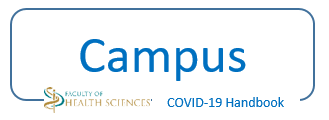
CAMPUS
Welcome back to the Faculty of Health Sciences campus.
Daily Screening App
All students will need to complete the Logbox App Screening tool form and receive a Cleared message to enter any Wits Campus areas. You will need to show the Cleared message to the Security as well as present your student ID card at the turnstiles. The biometrics for finger print has been disabled. You may also be asked to present your travel permit. Click here to go to the Screening & Testing section for information on the Wits Logbox App Screening tool.
Cloth masks, hand hygiene and social distancing
All students and staff are to wear cloth masks when entering campus, as well as follow proper hand hygiene and social distancing rules at all times for maintaining at least 1.5 to 2 meters apart from another person. Students are not to gather in groups. Follow compulsory sessions on campus, students are to return to residence or home, inline with Level 3 regulation (as at June 2020). Any infraction of the rules can result in disciplinary action, including being escorted off campus.
Hand sanitiser stations are located at all entrances to be used often. All common areas, teaching venues as well as furniture will be disinfected in line with Wits University guidelines.
Face to Face (F2F) Teaching & Assessment sessions
Students have been allowed to return to campus in order to complete the academic year where campus resources are needed - access to clinical sites, laboratories, clinical skills rooms and for assessment purposes following Lockdown regulations. Therefore, face-to-face teaching and/or assessment sessions must follow the regulations with blended learning methodologies to support and enrich face-to-face teaching activities. Please follow the guidelines when engaging in F2F sessions to keep all of us safe.
|
Levels of Restriction |
Key Faculty Components |
|||
|
Students and Staff |
Teaching & Learning |
Courses and Resources |
Learning spaces |
|
|
Level 1: Low virus spread; high health system readiness |
Majority of staff and student RTC |
Online learning continues; minimal contact in small groups |
All courses online, with minimal small group interaction |
Limited opening of lecture halls for social distancing; all labs open for research and teaching. |
|
Level 2: Moderate virus spread with high readiness |
Preclinical and “off-line” student RTC; increase staff complement to RTC |
Online learning continues; limited small group learning |
All courses online, with essential small group interaction e.g. clinical debriefing |
Limited opening of lecture halls for social distancing; most labs open for teaching & learning, research, clinical skills. |
|
Level 3: Moderate virus spread with moderate readiness |
Phased-in RTC of clinical and lab-based students; RTC of essential staff only |
Online learning continues; training for all other clinical students |
All courses online; WHSL partial reopening, Device and data access secured |
All lecture and dissection halls closed; tut rooms, selected labs reopen for clinical skills; research |
|
Level 4: Moderate to high virus spread with low to moderate readiness |
Phased-in RTC of clinical students; RTC of limited essential staff only |
Online learning continues; commence clinical training for final year students |
All courses online; Device and data access secured WHSL closed; learning resources online |
All lecture and dissection halls , labs remain closed; reset some labs for video dissections |
|
Level 5: High virus spread and or low readiness |
No students and staff on campus; |
Remote, online learning only |
Courses formatted for online offering; WHSL closed - learning resources online; secure devices & data access |
All lecture halls, tutorial rooms, libraries, museums, all labs, including computer labs closed. |
CLASSROOMS & LECTURE HALLS
Only 33% of normal capacity will be allowed in the classrooms and lecture halls. All students and faculty to adhere to the rules of wearing cloth mask, hand hygiene and social distancing with at least 1.5 to 2 meters apart from each other. Venues are to be booked through the FHS Venue Online Booking system, email christeleen.ontong@wits.ac.za. Cleaning staff will then be informed of venue use and date for pre/post cleaning requirements.
COMPUTER LABS
Closed to student use at this time. Only Course Coordinators/Administrators to book computer labs through the FHS Venue Online Booking system for scheduled assessment sessions. Only 33% capacity with students and faculty to adhere to the rules of wearing cloth mask, hand hygiene and social distancing with at least 1.5 to 2 meters apart from each other. Cleaning staff will pre/post clean all surfaces, computer hardware and furniture following University guidelines.
CLINICAL SKILLS UNIT on 3rd Floor
Student will need to complete the Wits Logbox App Screening tool prior to attending clinical sessions. All students and staff to wear cloth masks at all times, with 1.5 to 2 meters social distancing in the central area and no more than 5 students in a small clinical exam room at one time for a maximum of 45 students per clinical session using 9 clinical exam rooms. There will be no large group teaching in central room location. Less than 30 students for OSCE session spread out for 30 stations. Models and surfaces will be wiped down between each use and hand sanitiser will be available for before and after every procedure and examination. Holding venues will be set up for OSCEs for social distancing - no more than 30 students spread out over a large lecture theatre.
SMALL GROUP LEARNING (SGL) ROOMS on 3rd Floor
The SGL rooms are not available for individual or group student use. The SGL rooms can be booked by Faculty for clinical teaching sessions or OSCE assessment of students. All rules pertaining to the Clinical Skills Unit for student groups size and social distancing will apply to the SGL rooms.
SIM LAB on 4th Floor
Student will need to complete the Wits Logbox App Screening tool prior to attending SIM clinical sessions. All students and staff to wear cloth masks at all times, with 1.5 to 2 meters social distancing. Only 30% of capacity allowed in the SIMlab. This is equivalent to 10 persons as the max according to fire hazard is 35 people. All bookings for the SimLab must be made through Hilary Thurling (hilary.thurling@wit.ac.za). Bookings will be placed on the central booking system to facilitate cleaning. Only one student group will be allowed in the SimLab per day - to allow time for cleaning of the SimLab between groups. All other COVID precautions will be in place. Hand washing, wearing of masks is compulsory and face shields for close participant interaction when working with a simulator manikin.
PRACTICAL LABORATORIES
Each School to use per guidelines.
RESEARCH LABORATORIES
Each School to use per guidelines.
WITS HEALTH SCIENCES LIBRARY
Closed to student use at this time until further notice.
OLIVES & PLATES
The eatery in the Faculty building is open for service following current regulations for food services. Students and staff are requested to obey new rules put in place which are posted with signs and listed below:
- All patrons will need to wear a face mask
- As well as sanitise their hands before they enter the eatery
- They must adhere to social distancing as shown by the floor stickers
- Patrons to sanitise their hands after exchanging money/cards with the cashiers – card payments more advisable
- The flow for waiting at call order – only two people per time in the call order section and the rest will have to keep the 2m distance behind.
- Collecting, and taking items from the fridges – only one person can access the fridges at a time
Please follow all instructions as displayed on signs placed throughout the eatery. We are all safe when we all practice social distancing, hand hygiene and wearing a mask.
The eatery on the ground floor of the Philip Tobias building will remain closed until further notice.
BATHROOMS
Shared bathrooms to have social distancing with no more than 2-3 persons wearing cloth mask, proper hand hygiene, 1.5 to 2 meter distance and closed toilet lid when flushing.
ELEVATORS
- Wear cloth masks
- Use hand sanitiser prior/post use of lift
- Not more than 4 people per lift and stand at the corners of lift
- Encourage use of the stairs - it’s healthier!
GARDEN AREA
Students are encouraged to return to their place of residence following any activity on campus. Students are discouraged from gathering, we are following the Level 3 Lockdown guidelines for wearing cloth mask, hand hygiene and social distancing with at least 1.5 to 2 meters apart from another person, with no large group gatherings.
Residence
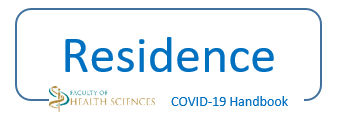
Sections covered include:
Wits Residence
Dinning Hall
Quarantine/isolation in Wits Residence
Wits Residence
WITS RESIDENCE RULES
Wits Residence Services welcomes you back to your residence. All Wits Residences are now open following cleaning and establishment of requirements set forth by Regulations. Some Wits Residence may reach the maximum 33% capacity of residence as set forth in the national guidelines. Therefore, some students may be relocated from their Wits residence to another near by Wits residence to keep within the 33% maximum capacity during Level 3 Lockdown. Arrangements will be made for students to collect personal items from their room to relocate to another room in an alternate residence. We appreciate your understanding and cooperation with following the regulations.
Your return to the residence is primarily for study purposes, therefore stay and remain in your room unless you have approval to leave your room. #StayAtHome. Please follow the new rules to observe due to COVID-19:
- You will need to complete the Wits Logbox App Screening form to enter a Wits Residence, with a cleared message shown to Security.
- Wear your face cloth mask whenever you leave your rooms.
- Continually use hand sanitizers (60% alcohol or more), to be provided in easily accessible places like residence kitchens, bathrooms and along passages.
- Always observe the two metres social distancing, whether in public spaces, at laundry waiting for your turn, or the queue waiting for the bus.
- You are not permitted to receive any visitor in your room.
- No socializing is permitted at the residence for the duration of your stay.
- No gatherings, including meetings, group studying, etc. is permitted
- You will only be allowed to exit your residence for essential tasks, e.g. attend course sessions, labs, clinical work, medical emergency, visiting shops for groceries.
- During level 3 students must report their movements to the residence management should they wish to leave the residence for any reason other than the ones mentioned above.
- Exercising will be allowed outside the residence parameters as per the Regulations under strict public health conditions.
- No organized exercising will be allowed. You are encouraged to exercise individually.
- There will be no housekeeping services provided for individual rooms - only common and public areas will be cleaned.
- Sanitising the surfaces of workstations, toilet handles, door handles, doorknobs, telephones, desk surfaces, common tools, keyboards to be carried out by the cleaning staff.
- Common areas such as the TV lounge will not be open
- Only one student can access the bathroom at any given time in residences where bathrooms are shared.
- The laundry room will need to be booked on a schedule basis so as to limit the number of people accessing the space at one time
- Only three students can use the kitchen at any time while maintaining a minimum social distance of 2 metres, based on the size of the kitchen, where kitchens are shared.
- Regular monitoring will be done by the site administrator.
For any queries related to Wits Residence, please contact basil.mugwena@wits.ac.za
Click here for link to Wits Residence on Wits website
Dinning Hall
DINING HALL & MEAL PLAN RULES

Wits Dining – Hygiene, Social Distancing and General Safety Procedures – COVID 19
Students and staff personnel are expected to conduct themselves in a courteous manner with the dining halls COVID 19 Social Distancing and Food Safety Protocol at all times
- No students will be allowed in the dining halls without a face mask, or a face mask not worn correctly
- Meals must be taken in a designated dining hall, following the dining hall signage and rules
- A minimum of 20 to a maximum of 50 students will be allowed to access the dining area at any given time
- Hands are to be sanitized with an alcohol-based hand rub that is available at the dining hall entrances and the servery area. Hand washing with soap and water is encouraged where facilities are available
- Students that are not booked in the dining halls are not permitted to enter any dining hall without reporting to the dining hall help desk for assistance
- Students to use their own pen when signing in for early meals at reception help desk
- Adhere to follow one way floor marking footsteps when exiting the dining hall turnstile
- Students inside the dining area to follow the floor marking footsteps protocol of 1.5 meter in at serving areas queues, and in all work stations within the dining hall
- No hugging, kissing, or shaking hands with other students or staff
- No cell phones are allowed in the servery area
- Avoid touching servery counter surfaces
- No touching of resale items in displays or fridges is allowed
- Hand disinfection is encouraged after touching any objects, access turnstiles, counter surfaces etc.
- Only 4 students are allowed to sit in a 10 square metre table to accommodate 1.5 m social distancing
- Tables and chairs are set to allow social distancing between students. No moving of chairs is allowed in the dining halls
- Meals to be consumed within 30 minutes when served
- No take away food should be kept in student rooms for more than stipulated time on the food label
- No hot meals will be taken out of the dining halls
Quarantine/Isolation in Wits Residence
QUARANTINE/SELF-ISOLATION/ISOLATION IN WITS RESIDENCE
See General Quarantine and Isolation description in Screening & Testing section
Transport
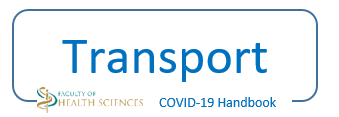
WITS BUS SERVICE PROTOCOL
The general campus bus service resumed on Monday 08 June 2020 for limited students currently on campus and require transport between Parktown Campus and Main Campus. Bus routes are transporting to Wits Hospitals as well as Wits Junction to Rosebank. The bus timetable is planned and published in line with the COVID-19 Lockdown Level 3 Regulations and Protocols. Students are requested to observe the protocols in place to ensure their safely and of others.
Click here for Wits Transport Bus Schedules
RESPONSIBILITY OF UNIVERSITY
- Manage social distancing on the queue waiting for the bus
- Hand Sanitizer dispensers installed at the entrance inside each bus
- 65 seater with maximum 26 passengers seated in each bus
- The seating arrangement or capacity is to comply and enable social distancing
- Driver cubicle is installed to eliminate any form of contact
- Disposable plastic bags on each bus at the entrance or exit
- Buses to pick-up at AMIC Deck, the Wits Junction Residence and EOH Blackwood Ave
- The drop-off for the Wits Junction will be the entrance to allow screening protocols
- Buses to be decontaminated before commencing a route or trip and after a trip
RESPONSIBILITY OF PASSENGERS
- Maintain social distancing when queuing for the bus
- Must wear a face mask
- Passengers to produce their student cards and permits before boarding
- To use hand sanitizer before boarding and when exiting the bus
- Maintain social distancing when seating in the bus
- Please do not litter in the bus, use the disposable bags at the exist or entrance of the bus
For any queries related to Wits Transport, please contact Transport.Services@wits.ac.za or Timothy.Mudau@wits.ac.za
Standby number is 066 181 7780
Thank you and Travel Safe
Student Support

Sections covered:
Office of student success
Resilience training
Adjusting to change
Medical emergency
Covid-19 call centres hotlines
Office of Student Support
YOU MATTER!
The Office of Student Success (0SS) continues to provide the following support to FHS students during the COVID-19 pandemic, namely:
ACADEMIC ADVISING
- Individual advising as per student needs and requests through WhatsApp calls.
- Online sessions (including video conferencing where necessary and possible) for 1st year students as planned via Moodle.
- Class sessions agreed upon with Year Coordinators before COVID-19 are proceeding as per revised teaching calendar. These sessions will be asynchronous, and are posted on individual classes’ eLearning platforms managed by Year Coordinators (both SAKAI and Moodle).
- OSS-funded Physics and Chemistry tutorials for 1st years are continuing via SAKAI course pages.
NB: Peer tutoring has been put on hold for now, to allow students to adjust to online learning. Students who require additional subject content support will be referred to Course Coordinators.
COUNSELLING
- Confidential e-counselling through Microsoft Teams for individual students as and when requested.
- Containment of students in crisis and appropriate referral to mental health resources will be guided by the OSS Crisis Management Protocol.
- Online debriefings for 10 students facilitated via Microsoft Teams over 45 minute session.
- Course Coordinators may request workshops based on students’ psychosocial challenges. Online guides, mental health kits or VoPPs can be designed.
To access any of the above support, email studentsupport.health@wits.ac.za
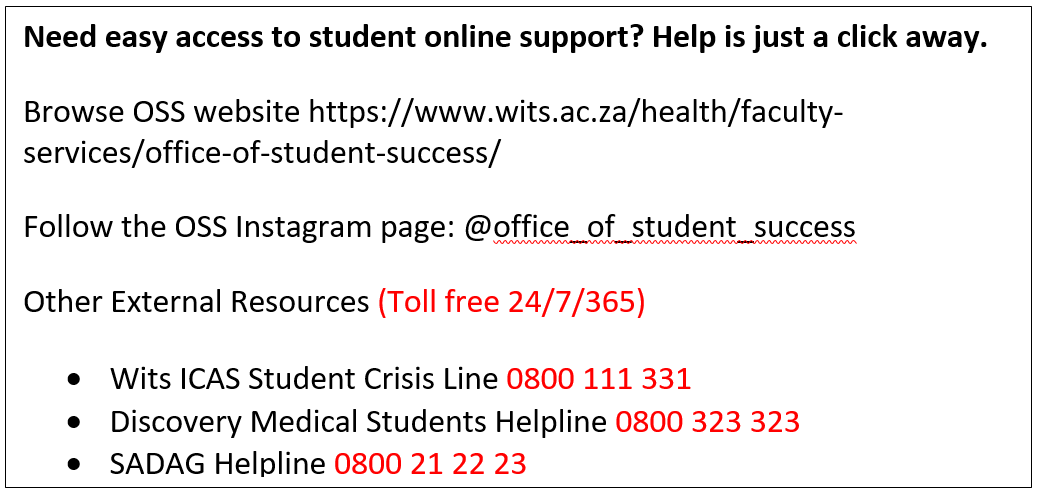
#MAKEADIFFERENCE CAMPAIGN including accessing ‘Care Kits’
The needs of students in the Faculty of Health Sciences at Wits University are diverse. Like all tertiary institutions, Wits endeavours to ensure that the diverse needs of students are met so that they can realize their career goals with success and dignity.
There are students who are impacted by their financial and socioeconomic circumstances, which results in their basic needs not being met - among these, the need for food security, hygiene and personal care. The OSS is committed to improve the lives of students who experience such hardships through the #MakeaDifference Campaign. This includes sourcing donations of food items and/or toiletries so that these students can receive a ‘Care Kit’.
STUDENTS ELIGIBLE TO RECEIVE CARE KITS
- Students who are self-funded and whose bursaries are not yet processed and active.
- Students who report to have minimal financial support and have requested to return to campus due to difficult home circumstances.
NB: Students who have financial aid such as bursaries and NSFAS and request further assistance will be referred to the WCCO.
COLLECTION STATION
- Students can collect care kits from the Student Liaison Hub, Medical School, 4th floor entrance. Collection dates will be communicated at FHS Logistics/Operations Student Return to Campus Committee meetings or via email to Course Coordinators.
- Students who are not able to collect care kits on collection dates, may email anelisa.mofakeng1@wits.ac.za to arrange a suitable date/time.
ADMINISTRATIVE PROCESS
- Students will be expected to complete the #MakeaDifference Recipient Form prior to receiving a care kit.
- This administrative process is essential as the OSS needs to maintain a database of students who may be required to source care kits in future.
PRECAUTIONARY MEASURES
- All students receiving care kits are requested to wear a cloth face mask.
- Students are expected to sanitize their hands by the Medical School entrance as well as adhere to the 1.5m social distancing requirement when collecting care kits.
NB: Any student that does not adhere to these safety procedures will not be assisted.
Kindly note the distribution of care kits depends heavily on the available stock of food items and toiletry supplies from donors. The OSS will consequentially refer students to WCCO.
Click here to go to the Wits Office of Student Success website
Resilience Training
WELCOME TO THE RESILIENCE TRAINING WORKSHOP
"These are challenging times, which can play on our minds. Yet our minds are the most important tool we have to make choices and decisions for how we can cope" - Sieger, 2020
Resilience is the ability to deal with negative experiences and emotions, manage anxiety and make progress to achieve goals despite challenges and difficulties.
This is a very important skill, and especially for healthcare professionals who learn and work in extremely demanding environments with a heavy burden of responsibility.
The OSS has prepared a Resilience Workshop for you, which will be presented in 4 parts. In total, it should take you about 2 hours to work through all four the narrated presentations and complete the tasks/reflective exercises. Please make sure that you have a notepad or device handy while you work through the presentations in order to complete these exercises.
Remember that you can still access the OSS during this time for any online academic advising and counselling needs.
Adjusting to Change
We are finding ourselves in unprecedented times. Everything which is familiar to us is changing. During this pandemic situation, we are all learning to adapt, grow and changes. This brochure will provide useful information and tools to adjust to the change.
Access the brochure here
The SARS-CoV-2 virus is new and unfamiliar to us all. It is imperative we take time to understand the virus, learn the steps to protect ourselves, family, friends and fellow South Africans. This includes using non-stigmatising words and actions when discussing and talking about the virus or someone who is ill with COVID-19. This brochure by WHO shares the correct wording for us to support and help all of us to live with COVID-19.
Access the brochure here
Medical Emergency
Injury/Medical Emergency
What to do during incidents involving an injury/medical emergency:
Notify Wits Protection Services as well as other relevant emergency response entities at:
• Wits Campus Health & Wellness Centre: 011 717 9111 / 011 717 9113
• Wits Protection Services, Main Control Room, Braamfontein: 011 717 4444 / 011 717 6666
• Wits Protection Services, Health Sciences Campus: 011 717 2222 / 011 717 2232
• Wits Protection Services, Education Campus: 011 717 3340
• Wits Protection Services, Management Campus: 011 717 3589
• Wits Emergency Response Coordinator: 011 717 9192 / 084 627 359
When communicating with the above entities please provide them with
• Your name
• Contact details
• An accurate description of the nature of the injury/medical emergency and the location of the incident.
• Request for an ambulance if it is required
Only provide first aid assistance if you have been trained to do so.
COVID-19 Call Centres/Hotlines

